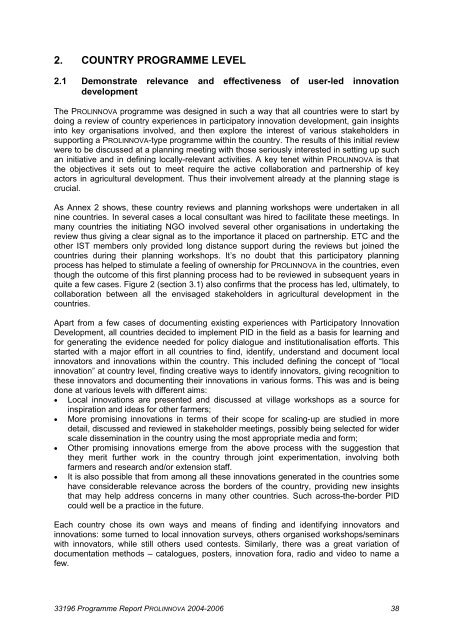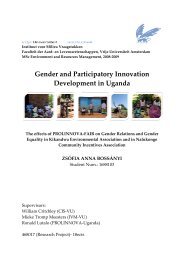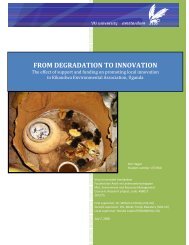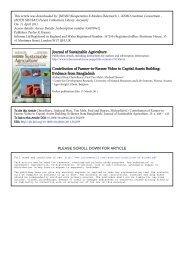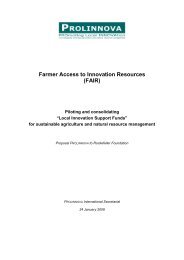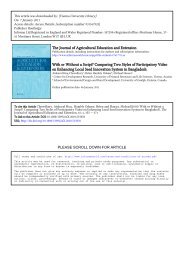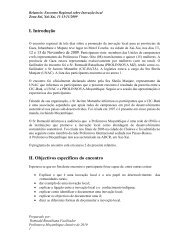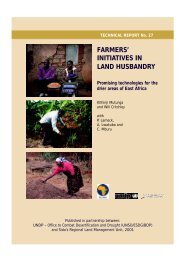2006 ANNUAL REPORT & PROGRAMME REPORT ... - Prolinnova
2006 ANNUAL REPORT & PROGRAMME REPORT ... - Prolinnova
2006 ANNUAL REPORT & PROGRAMME REPORT ... - Prolinnova
Create successful ePaper yourself
Turn your PDF publications into a flip-book with our unique Google optimized e-Paper software.
2. COUNTRY <strong>PROGRAMME</strong> LEVEL<br />
2.1 Demonstrate relevance and effectiveness of user-led innovation<br />
development<br />
The PROLINNOVA programme was designed in such a way that all countries were to start by<br />
doing a review of country experiences in participatory innovation development, gain insights<br />
into key organisations involved, and then explore the interest of various stakeholders in<br />
supporting a PROLINNOVA-type programme within the country. The results of this initial review<br />
were to be discussed at a planning meeting with those seriously interested in setting up such<br />
an initiative and in defining locally-relevant activities. A key tenet within PROLINNOVA is that<br />
the objectives it sets out to meet require the active collaboration and partnership of key<br />
actors in agricultural development. Thus their involvement already at the planning stage is<br />
crucial.<br />
As Annex 2 shows, these country reviews and planning workshops were undertaken in all<br />
nine countries. In several cases a local consultant was hired to facilitate these meetings. In<br />
many countries the initiating NGO involved several other organisations in undertaking the<br />
review thus giving a clear signal as to the importance it placed on partnership. ETC and the<br />
other IST members only provided long distance support during the reviews but joined the<br />
countries during their planning workshops. It’s no doubt that this participatory planning<br />
process has helped to stimulate a feeling of ownership for PROLINNOVA in the countries, even<br />
though the outcome of this first planning process had to be reviewed in subsequent years in<br />
quite a few cases. Figure 2 (section 3.1) also confirms that the process has led, ultimately, to<br />
collaboration between all the envisaged stakeholders in agricultural development in the<br />
countries.<br />
Apart from a few cases of documenting existing experiences with Participatory Innovation<br />
Development, all countries decided to implement PID in the field as a basis for learning and<br />
for generating the evidence needed for policy dialogue and institutionalisation efforts. This<br />
started with a major effort in all countries to find, identify, understand and document local<br />
innovators and innovations within the country. This included defining the concept of “local<br />
innovation” at country level, finding creative ways to identify innovators, giving recognition to<br />
these innovators and documenting their innovations in various forms. This was and is being<br />
done at various levels with different aims:<br />
Local innovations are presented and discussed at village workshops as a source for<br />
inspiration and ideas for other farmers;<br />
More promising innovations in terms of their scope for scaling-up are studied in more<br />
detail, discussed and reviewed in stakeholder meetings, possibly being selected for wider<br />
scale dissemination in the country using the most appropriate media and form;<br />
Other promising innovations emerge from the above process with the suggestion that<br />
they merit further work in the country through joint experimentation, involving both<br />
farmers and research and/or extension staff.<br />
It is also possible that from among all these innovations generated in the countries some<br />
have considerable relevance across the borders of the country, providing new insights<br />
that may help address concerns in many other countries. Such across-the-border PID<br />
could well be a practice in the future.<br />
Each country chose its own ways and means of finding and identifying innovators and<br />
innovations: some turned to local innovation surveys, others organised workshops/seminars<br />
with innovators, while still others used contests. Similarly, there was a great variation of<br />
documentation methods – catalogues, posters, innovation fora, radio and video to name a<br />
few.<br />
33196 Programme Report PROLINNOVA 2004-<strong>2006</strong> 38


